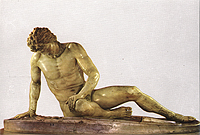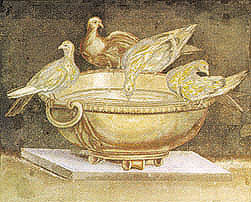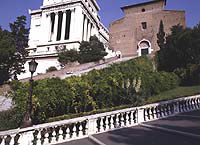Campidoglio
Palazzo Nuovo
 (1644-55. Michelangelo, Girolamo Rainaldi). Is on the left of the square when looking at the central Senator's Palace.
(1644-55. Michelangelo, Girolamo Rainaldi). Is on the left of the square when looking at the central Senator's Palace.
Courtyard. Center Fountain of a reclining statue named Marforio was one of the "talking statues" in Rome, originally located on one of Rome's streets. When the populace were dissatisfied they hung a sign around the statue's neck with their complaint, often in rhyme.
Glass bay on the right. Equestrian Marcus Aurelius, 2C AD. This glorious statue of the Emperor, his hand outstretched to the populace, has been restored to its former beauty, much of its gold leaf still shining dully.
Because it was mistaken for Constantine, the first Christian Emperor, this statue survived the Church's anti-Pagan campaigns in all its glory, and gives us an idea of how fabulous ancient Rome must have been with so many statues of this quality. To see it without a glass reflection, go to the small window on the right.
One floor up. Hall 1. Dying Gaul, 3C BC Marble. There is pathos in this finely wrought figure. Found in Sallust's garden. Hadrian's friend and love, Antinous, is the lovely young man in white marble on the right, with a bruised knee (in reality just a blemish in the marble).
Hall 2. Hadrian as Mars. 2C AD. Emperor Hadrian was a soldier-philosopher-architect. Perhaps another portrait of his love Antinous is on his right. Many of the statues here came from Hadrian's Villa in Tivoli.
 Hall 4 of the Philosophers. Not all are philosophers, though there are 3 of Socrates, 1 of Homer and 3 of Cicero. The central statue of a young warrior is Marcellus, builder of that wonderful Teatro di Marcello, near the Tiber Island.
Hall 4 of the Philosophers. Not all are philosophers, though there are 3 of Socrates, 1 of Homer and 3 of Cicero. The central statue of a young warrior is Marcellus, builder of that wonderful Teatro di Marcello, near the Tiber Island.
Hall 5 of the Emperors 65 busts, but not all Emperors. Roman portraiture did not idealize the subject, and this room certainly shows the warts and all. Try to pick out Nero: young with a fringe, but he doesn't look crazy at all. On a column, a sensitive portrait of young Augustus, 1C BC. His wife Livia is in the right hand corner, 2nd shelf, and has a grand headdress and pursed lips: a strong woman.
Portrait of a Flavian Lady, on a column 1C AD Fine artistic work. Fine hair-do, but it must have taken her hours every day. Long corridor.
Octagonal room on left returning to staircase: "Capitoline Venus" 2C AD. Marble. An ancient Roman copy of a Praxitiles original. Modest "Venus" surprised at the bath. The room has copies of Roman frescoes to give one a flavor of what it would have been like then. Very successful.
Gallery 35. Part of the long corridor, "Drunken old woman" 3C BC. She's gripping her wine flask. Just like Chianti today - only bigger, and in terra-cotta.
Hall 8. "Dove Mosaic", 2C. This beautiful mosaic of doves drinking from a golden bowl is from Hadrian's Villa. Copied a 1,000 times during subsequent centuries - but none as beautiful as the original. This too is a copy of an ancient Greek mosaic.
| Palazzo Nuovo History 1603. Work began on this building, completed 50 years later with funds from Pope Innocent X Pamphili. Michelangelo's drawings were followed for the facade, so that the piazza would have a united look. Another Museum for Antiquities was needed, since more ancient Roman artifacts came to light as they cleared away centuries of rubble. 1734. Pope Clement XII Corsini opened the Museum this side, allowing the public access to these collections of antique sculptures to which additions were made later by successive Popes. |
![]()
Our favorites: Marcus Aurelius on his favorite horse. And the Dove Mosaic.
Open Tuesday through Saturday 9 am - 7 pm. Sunday open 9 am to 6:45 pm. Closed Monday. Free admission last Sunday of month
(Map H 6)
St. Maria in Aracoeli

122 steep steps from the Piazza of the same name, this Medieval church first belonged to the Benedictines and then to the Franciscans.
The wooden Christ child in the sacristy, venerated for having worked medical miracles, is moved to the nativity scene in the second chapel of the left nave at Christmas when children are encouraged to recite prayers.
You can also enter from the top of the Capitoline Hill.